Modeling the Impact of Investment and National Planning Policies on Future Land Use Development: A Case Study for Myanmar
Abstract
1. Introduction
2. Study Area and Data Sources
2.1. Study Area
2.2. Data Collection and Processing
3. Methodology
3.1. Simulating the Land Use Structure by Considering the Impacts of Investment
3.2. Characterizing the Land Use Allocation by Considering the Impacts of Planning Policies
3.2.1. Description of the FLUS Model
3.2.2. The Updated Mechanism Considering the Impacts of Planning Policies
3.3. Land Use Simulation Setting and Scenario Design
3.3.1. Setting of Model Implementation
3.3.2. Scenario Design
3.4. Accuracy Assessment
4. Results and Analysis
4.1. Validation of Model Simulations
4.1.1. Accuracy of the Simulated Land Use Structure
4.1.2. Accuracies of the Simulated Land Use Patterns
4.2. Performance of the Proposed Updated Mechanism for Planning Policies
4.3. Projected Land Use Structures from 2017 to 2050 in Myanmar
4.4. Simulated Spatial Pattern Dynamics in Myanmar
5. Discussion
5.1. Policy-Level Drivers of Land Use Change in Myanmar
5.2. Land Use Patterns under Different Scenarios
5.3. Uncertainties and Future Work
6. Conclusions
Supplementary Materials
Author Contributions
Funding
Data Availability Statement
Acknowledgments
Conflicts of Interest
References
- Wang, C.; Wang, Y.; Wang, R.; Zheng, P. Modeling and evaluating land-use/land-cover change for urban planning and sustainability: A case study of Dongying city, China. J. Clean. Prod. 2018, 172, 1529–1534. [Google Scholar] [CrossRef]
- Roger, A.; Pielke, S. Land Use and Climate Change. Science 2005, 310, 1625–1626. [Google Scholar]
- Jin, G.; Chen, K.; Wang, P.; Guo, B.S.; Dong, Y.; Yang, J. Trade-offs in land-use competition and sustainable land development in the North China Plain. Technol. Forecast. Soc. Change 2019, 141, 36–46. [Google Scholar] [CrossRef]
- Lambin, E.F.; Meyfroidt, P. Global land use change, economic globalization, and the looming land scarcity. Proc. Natl. Acad. Sci. USA 2011, 108, 3465–3472. [Google Scholar] [CrossRef]
- Verburg, P.H.; Schulp, C.J.E.; Witte, N.; Veldkamp, A. Downscaling of land use change scenarios to assess the dynamics of European landscapes. Agric. Ecosyst. Environ. 2006, 114, 39–56. [Google Scholar] [CrossRef]
- Zhang, G.; Zheng, D.; Wu, H.; Wang, J.; Li, S. Assessing the role of high-speed rail in shaping the spatial patterns of urban and rural development: A case of the Middle Reaches of the Yangtze River, China. Sci. Total Environ. 2020, 704, 135399. [Google Scholar] [CrossRef]
- Muller, M.R.; Middleton, J. A Markov model of land-use change dynamics in the Niagara Region, Ontario, Canada. Landsc. Ecol. 1994, 9, 151–157. [Google Scholar]
- Luo, G.; Yin, C.Y.; Chen, X.; Xu, W.; Lu, L. Combining system dynamic model and CLUE-S model to improve land use scenario analyses at regional scale: A case study of Sangong watershed in Xinjiang, China. Ecol. Complex. 2010, 7, 198–207. [Google Scholar] [CrossRef]
- Zheng, X.Q.; Zhao, L.; Xiang, W.N.; Li, N.; Lv, L.N.; Yang, X. A coupled model for simulating spatio-temporal dynamics of land-use change: A case study in Changqing, Jinan, China. Landsc. Urban Plan. 2012, 106, 51–61. [Google Scholar] [CrossRef]
- Deng, X.Z. Modeling the Dynamics and Consequences of Land System Change; Higher Education Press: Beijing, China, 2010. [Google Scholar]
- Verburg, P.H.; Eickhout, B.; van Meijl, H. A multi-scale, multi-model approach for analyzing the future dynamics of European land use. Ann. Reg. Sci. 2008, 42, 57–77. [Google Scholar] [CrossRef]
- Deng, X.Z.; Yin, F.; Lin, Y.Z.; Jin, Q.; Qu, R.J. Equilibrium analyses on structural changes of land uses in Jiangxi Province. J. Food Agric. Environ. 2012, 10, 846–852. [Google Scholar]
- Verburg, P.H.; Soepboer, W.; Veldkamp, A.; Limpiada, R.; Espaldon, V.; Mastura, S.S. Modeling the spatial dynamics of regional land use: The CLUE-S model. Environ. Manag. 2002, 30, 391–405. [Google Scholar] [CrossRef]
- Liu, X.P.; Liang, X.; Li, X.; Xu, X.C.; Ou, J.P.; Chen, Y.M.; Li, S.Y.; Wang, S.J.; Pei, F.S. A future land use simulation model (FLUS) for simulating multiple land use scenarios by coupling human and natural effects. Landsc. Urban Plan. 2017, 168, 94–116. [Google Scholar] [CrossRef]
- Wang, Q.; Guan, Q.; Lin, J.; Luo, H.; Tan, Z.; Ma, Y. Simulating land use/land cover change in an arid region with the coupling models. Ecol. Indic. 2021, 122, 107231. [Google Scholar] [CrossRef]
- Liang, X.; Liu, X.; Li, X.; Chen, Y.; Tian, H.; Yao, Y. Delineating multi-scenario urban growth boundaries with a CA-based FLUS model and morphological method. Landsc. Urban Plan. 2018, 177, 47–63. [Google Scholar] [CrossRef]
- Guo, H.; Cai, Y.; Yang, Z.; Zhu, Z.; Ouyang, Y. Dynamic simulation of coastal wetlands for Guangdong-Hong Kong-Macao Greater Bay area based on multi-temporal Landsat images and FLUS model. Ecol. Indic. 2021, 125, 107559. [Google Scholar] [CrossRef]
- Chen, Z.; Huang, M.; Zhu, D.; Altan, O. Integrating Remote Sensing and a Markov-FLUS Model to Simulate Future Land Use Changes in Hokkaido, Japan. Remote Sens. 2021, 13, 2621. [Google Scholar] [CrossRef]
- Li, X.; Liu, X. An extended cellular automaton using case-based reasoning for simulating urban development in a large complex region. Int. J. Geogr. Inf. Sci. 2006, 20, 1109–1136. [Google Scholar] [CrossRef]
- Viana, C.M.; Santos, M.; Freire, D.; Abrantes, P.; Rocha, J. Evaluation of the factors explaining the use of agricultural land: A machine learning and model-agnostic approach. Ecol. Indic. 2021, 131, 108200. [Google Scholar] [CrossRef]
- Brady, M.; Sahrbacher, C.; Kellermann, K.; Happe, K. An agent-based approach to modeling impacts of agricultural policy on land use, biodiversity and ecosystem services. Landsc. Ecol. 2012, 27, 1363–1381. [Google Scholar] [CrossRef]
- Cheng, Q.; Jiang, P.; Cai, L.; Shan, J.; Zhang, Y.; Wang, L.; Li, M.; Li, F.; Zhu, A.; Chen, D. Delineation of a permanent basic farmland protection area around a city centre: Case study of Changzhou city, China. Land Use Policy 2017, 60, 73–89. [Google Scholar]
- Zhao, L.; Shen, L. The impacts of rail transit on future urban land use development: A case study in Wuhan, China. Transp. Policy 2019, 81, 396–405. [Google Scholar] [CrossRef]
- Liang, X.; Liu, X.; Chen, G.; Leng, J.; Wen, Y.; Chen, G. Coupling fuzzy clustering and cellular automata based on local maxima of development potential to model urban emergence and expansion in economic development zones. Int. J. Geogr. Inf. Sci. 2020, 34, 1930–1952. [Google Scholar] [CrossRef]
- Liang, X.; Liu, X.P.; Li, D.; Zhao, H.; Chen, G.Z. Urban growth simulation by incorporating planning policies into a CA-based future land-use simulation model. Int. J. Geogr. Inf. Sci. 2018, 32, 2294–2316. [Google Scholar] [CrossRef]
- Lewis, D.J.; Yang, X.H.; Moise, D.; Roddy, S.J. Dynamic synergies between China’s Belt and Road Initiative and the UN’s Sustainable Development Goals. J. Int. Bus. Policy 2021, 4, 58–79. [Google Scholar] [CrossRef]
- Malaysia Says It Stands to Reap Benefits from Belt and Road Initiative. Available online: https://eng.yidaiyilu.gov.cn/qwyw/rdxw/32071.htm (accessed on 30 October 2017).
- Lechner, A.M.; Chan, F.K.S.; Campos-Arceiz, A. Biodiversity conservation should be a core value of China’s Belt and Road Initiative. Nat. Ecol. Evol. 2018, 2, 408–409. [Google Scholar] [CrossRef]
- Ng, L.S.; Campos-Arceiz, A.; Sloan, S.; Hughes, A.C.; Tiang, D.C.F.; Li, B.V.; Lechner, A.M. The scale of biodiversity impacts of the Belt and Road Initiative in Southeast Asia. Biol. Conserv. 2020, 248, 108691. [Google Scholar] [CrossRef]
- Rimal, B.; Zhang, L.; Keshtkar, H.; Wang, N.; Lin, Y. Monitoring and Modeling of Spatiotemporal Urban Expansion and Land-Use/Land-Cover Change Using Integrated Markov Chain Cellular Automata Model. ISPRS Int. J. Geo-Inf. 2017, 6, 288. [Google Scholar] [CrossRef]
- Leimgruber, P.; Kelly, D.S.; Steininger, M.K.; Brunner, J.; Müller, T.; Songer, M. Forest cover change patterns in Myanmar (Burma) 1990–2000. Environ. Conserv. 2005, 32, 356–364. [Google Scholar] [CrossRef]
- Bhagwat, T.; Hess, A.; Horning, N.; Khaing, T.; Thein, Z.M.; Aung, K.M.; Aung, K.H.; Phyo, P.; Tun, Y.L.; Oo, A.H.; et al. Losing a jewel-Rapid declines in Myanmar’s intact forests from 2002–2014. PLoS ONE 2017, 12, e0176364. [Google Scholar] [CrossRef]
- Vadrevu, K.; Heinimann, A.; Gutman, G.; Justice, C. Remote sensing of land use/cover changes in South and Southeast Asian Countries. Int. J. Digit. Earth 2019, 12, 1099–1102. [Google Scholar] [CrossRef]
- Jin, Y.; Li, A.N.; Bian, J.H.; Nan, X.; Lei, G.B.; Muhammad, K. Spatiotemporal analysis of ecological vulnerability along Bangladesh-China-India-Myanmar economic corridor through a grid level prototype model. Ecol. Indic. 2021, 120, 106933. [Google Scholar] [CrossRef]
- Lim, C.L.; Prescott, G.W.; DeAlban, J.D.T.; Ziegler, A.D.; Webb, E.L. Untangling the proximate causes and underlying drivers of deforestation and forest degradation in Myanmar. Conserv. Biol. 2017, 31, 1362–1372. [Google Scholar] [CrossRef] [PubMed]
- Ministry of Planning and Finance. Myanmar Sustainable Development Plan (2018–2030). 2018. Available online: http://www.themimu.info/sites/themimu.info/files/documents/Core_Doc_Myanmar_Sustainable_Development_Plan_2018_-_2030_Aug2018.pdf (accessed on 20 August 2021).
- Ministry of Rail Transportation Myanmar Railways. Developing a Myanma’s Rail Network that Meet Demand. 2015. Available online: https://www.unescap.org/sites/default/files/Myanmar-TAR-WGM-4.pdf (accessed on 1 September 2021).
- Ministry of Rail Transportation Myanmar Railways. Rail Infrastructure Development Plan and Planning for International Railway Connectivity in Myanmar. 2019. Available online: https://www.unescap.org/sites/default/files/Item5_Myanmar_0.pdf (accessed on 5 September 2021).
- Myanmar Investment Commission. Myanmar Investment Promotion Plan. 2018. Available online: https://www.dica.gov.mm/sites/dica.gov.mm/files/news-files/mipp_english_version_with_cover_pages.pdf (accessed on 23 August 2021).
- Keuning, S.J.; de Ruuter, W.A. Guidelines to the Construction of a Social Accounting Matrix. Rev. Income Wealth 1988, 34, 71–100. [Google Scholar] [CrossRef]
- Keller, W.; Borkowski, A. Thin plate spline interpolation. J. Geod. 2019, 93, 1251–1269. [Google Scholar] [CrossRef]
- Navarro-Racines, C.; Tarapues, J.; Thornton, P.; Jarvis, A.; Ramirez-Villegas, J. High-resolution and bias-corrected CMIP5 projections for climate change impact assessments. Sci. Data 2020, 7, 7. [Google Scholar] [CrossRef]
- Saah, D.S.; Towashiraporn, P.; Aekakkararungroj, A.; Phongsapan, K.; Triepke, J.; Maus, P.; Tenneson, K.; Cutter, P.G.; Ganz, D.; Anderson, E. Mekong Land Cover Dasboard: Regional Land Cover Mointoring Systems. In AGU Fall Meeting Abstracts; American Geophysical Union: San Francisco, CA, USA, 2016; p. IN51B-1837. [Google Scholar]
- van Seventer, D.; Tarp, F.; San, N.N.; Htwe, S.T.N. A 2017 Social Accounting Matrix for Myanmar. In WIDER Working Paper 2020/66; UNU-WIDER: Helsinki, Sweden, 2020. [Google Scholar]
- Lloyd, C.T.; Chamberlain, H.; Kerr, D.; Yetman, G.; Pistolesi, L.; Stevens, F.R.; Gaughan, A.E.; Nieves, J.J.; Hornby, G.; MacManus, K.; et al. Global spatio-temporally harmonised datasets for producing high-resolution gridded population distribution datasets. Big Earth Data 2019, 3, 108–139. [Google Scholar] [CrossRef]
- Kummu, M.; Taka, M.; Guillaume, J.H.A. Data from: Gridded global datasets for Gross Domestic Product and Human Development Index over 1990–2015. Dryad 2020. [Google Scholar] [CrossRef]
- List of Railway Stations in Myanmar. Available online: https://en.wikipedia.org/wiki/List_of_railway_stations_in_Myanmar (accessed on 12 March 2022).
- MIMU. Myanmar Information Management Unit Geospatial Datasets. 2022. Available online: https://www.themimu.info/gis-resources-agency-maps (accessed on 26 March 2022).
- UNEP-WCMC. Protected Planet: The World Database on Protected Areas (WDPA); Cambridge University: Cambridge, UK, 2018. [Google Scholar]
- van Zyl, J.J. The Shuttle Radar Topography Mission (SRTM): A breakthrough in remote sensing of topography. Acta Astronaut. 2001, 48, 559–565. [Google Scholar] [CrossRef]
- Hengl, T.; Wheeler, I. Soil organic carbon content in x 5 g/kg at 6 standard depths (0, 10, 30, 60, 100 and 200 cm) at 250 m resolution, Version v0.2. Zenodo 2018. [Google Scholar] [CrossRef]
- Hengl, T. Soil pH in H2O at 6 standard depths (0, 10, 30, 60, 100 and 200 cm) at 250 m resolution, Version v0.2. Zenodo 2018. [Google Scholar] [CrossRef]
- Hengl, T. Clay content in % (kg/kg) at 6 standard depths (0, 10, 30, 60, 100 and 200 cm) at 250 m resolution, Version v0.2. Zenodo 2018. [Google Scholar] [CrossRef]
- CSO. Myanmar Statistical Yearbook; Central Statistical Organization: Yangon, Myanmar, 2018.
- Hapsari, T.S.; Amelia, R. Summary of ERIA Research Projects 2019–2020. 2021. Available online: https://think-asia.org/bitstream/handle/11540/13502/2020-July-Summary-Of-ERIA-Research-Projects-2019-2020-Interactive.pdf?sequence=1 (accessed on 17 May 2021).
- Lancang-Mekong Economic Zones. Available online: https://lmezs.com/lancang-mekong/myanmar/special-economic-zones/?type=Special+Economic+Zone (accessed on 15 March 2020).
- Xie, X.; Li, A.; Tian, J.; Wu, C.; Jin, H. A fine spatial resolution estimation scheme for large-scale gross primary productivity (GPP) in mountain ecosystems by integrating an eco-hydrological model with the combination of linear and non-linear downscaling processes. J. Hydrol. 2023, 616, 128833. [Google Scholar] [CrossRef]
- Myanmar Drafts New Five-Year Plan to Boost Economy. Available online: https://investvine.com/myanmar-drafts-new-five-year-plan-to-boost-economy/#:~:text=Myanmar%E2%80%99s%2020-year%20National%20Comprehensive%20Development%20Plan%20was%20framed,2030-31%20and%20its%20per%20capita%20GDP%20to%20%243%2C000.html (accessed on 17 December 2015).
- Saitama University. Long-Term Projection of Myanmar Economy by Macro Econometric Model. 2015. Available online: https://mpra.ub.uni-muenchen.de/64412/ (accessed on 23 May 2020).
- Myanmar Total Investment, % of GDP. Available online: https://data.nasdaq.com/data/ODA/MMR_NID_NGDP-myanmar-total-investment-of-gdp (accessed on 23 March 2020).
- Asian Productivity Organization. APO Productivity Databook 2014. 2014. Available online: https://www.apo-tokyo.org/publications/apo-productivity-databook-2014/ (accessed on 15 May 2021).
- Asian Productivity Organization. APO Productivity Databook 2020. 2020. Available online: https://www.apo-tokyo.org/publications/2020-apo-productivity-databook/ (accessed on 15 May 2021).
- Department of Population Ministry of Labour, Immigration and Population. Thematic Report on Population Projections for the Union of Myanmar, States/Regions, Rural and Urban Areas, 2014–2050. 2017. Available online: https://myanmar.unfpa.org/en/census (accessed on 23 August 2021).
- Ministry of Natural Resources and Environmental Conservation. Myanmar Climate Change Strategy (2018–2030). 2019. Available online: https://myanmar.un.org/sites/default/files/2019-11/MyanmarClimateChangeStrategy_2019.pdf (accessed on 17 May 2021).
- Haggblade, S.; Boughton, D.; Cho, K.M.; Denning, G.; Kloeppinger-Todd, R.; Oo, Z.; Sandar, T.M.; Than, T.M.; Wai, N.E.M.A.; Wilson, S.; et al. Strategic Choices Shaping Agricultural Performance and Food Security in Myanmar. J. Int. Aff. 2014, 67, 55–71. [Google Scholar]
- Tun, T.; Kennedy, A.; Nischan, U. Promoting Agricultural Growth in Myanmar: A Reviw of Policies and An Assessment of Knowledge Gaps. 2015. Available online: https://ageconsearch.umn.edu/record/259018/ (accessed on 11 October 2021).
- Linn, K.M.; Liang, W.C. Analysis of Forest Policy in Myanmar. Int. J. Sci. 2015, 4, 16–28. [Google Scholar]
- Deepak, B.R. Bangladesh, China, India, Myanmar Economic Corridor (BCIM-EC): Security Dilemma Rider to Regional Economic Integration. In China’s Global Rebalancing and the New Silk Road; Deepak, B.R., Ed.; Springer: Singapore, 2018; pp. 51–68. [Google Scholar]
- Than, M. Myanmar’s Cross-Border Economic Relations and Cooperation with the People’s Republic of China and Thailand in the Greater Mekong Subregion. J. GMS Dev. Stud. 2005, 2, 37–54. [Google Scholar]
- Tang, W.; Liu, M.; Liao, Y. Myanmar: Review of 2017 and Prospect of 2018. Crossroads Southeast Asian Stud. 2018, 1, 47–53. [Google Scholar]
- Sritarapipat, T.; Takeuchi, W. Land Cover Change Simulations in Yangon Under Several Scenarios of Flood and Earthquake Vulnerabilities with Master Plan. J. Disaster Res. 2018, 13, 50–61. [Google Scholar] [CrossRef]
- Goswami, U.C.; Basistha, S.K.; Bora, D.; Shyamkumar, K.; Saikia, B.; Changsan, K. Fish diversity of North East India, inclusive of the Himalayan and IndoBurma biodiversity hotspots zones: A checklist on their taxonomic status, economic importance, geographical distribution, present status and prevailing threats. Int. J. Biodivers. Conserv. 2012, 4, 592–613. [Google Scholar]
- Li, L.; Liu, J.; Long, H.; de Jong, W.; Youn, Y.-C. Economic globalization, trade and forest transition-the case of nine Asian countries. For. Policy Econ. 2017, 76, 7–13. [Google Scholar] [CrossRef]
- Rambonilaza, M.; Dachary-Bernard, J. Land-use planning and public preferences: What can we learn from choice experiment method? Landsc. Urban Plan. 2007, 83, 318–326. [Google Scholar] [CrossRef]
- Verburg, P.H.; Tabeau, A.; Hatna, E. Assessing spatial uncertainties of land allocation using a scenario approach and sensitivity analysis: A study for land use in Europe. J. Environ. Manag. 2013, 127, S132–S144. [Google Scholar] [CrossRef] [PubMed]
- Rao, Y.; Zhou, M.; Ou, G.; Dai, D.; Zhang, L.; Zhang, Z.; Nie, X.; Yang, C. Integrating ecosystem services value for sustainable land-use management in semi-arid region. J. Clean. Prod. 2018, 186, 662–672. [Google Scholar] [CrossRef]
- Lawler, J.J.; Lewis, D.J.; Nelson, E.; Plantinga, A.J.; Polasky, S.; Withey, J.C.; Helmers, D.P.; Martinuzzi, S.; Pennington, D.; Radeloff, V.C. Projected land-use change impacts on ecosystem services in the United States. Proc. Natl. Acad. Sci. USA 2014, 111, 7492–7497. [Google Scholar] [CrossRef]
- Mendoza-González, G.; Martínez, M.L.; Lithgow, D.; Pérez-Maqueo, O.; Simonin, P. Land use change and its effects on the value of ecosystem services along the coast of the Gulf of Mexico. Ecol. Econ. 2012, 82, 23–32. [Google Scholar] [CrossRef]
- Pejchar, L.; Mooney, H.A. Invasive species, ecosystem services and human well-being. Trends Ecol. Evol. 2009, 24, 497–504. [Google Scholar] [CrossRef]
- Tallis, H.; Kareiva, P.; Marvier, M.; Chang, A. An Ecosystem Services Framework to Support Both Practical Conservation and Economic Development. Proc. Natl. Acad. Sci. USA 2008, 105, 9457–9464. [Google Scholar] [CrossRef]

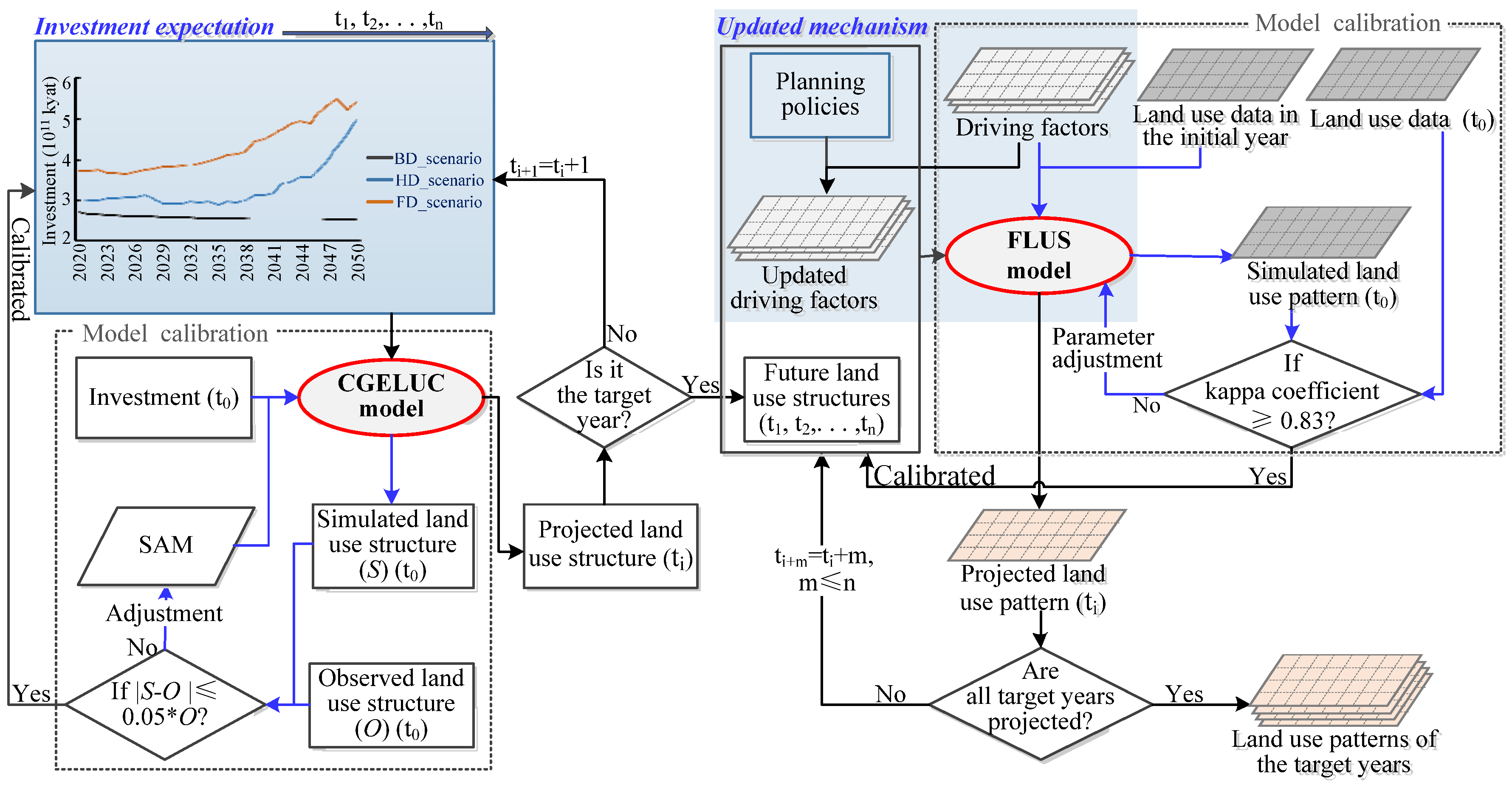

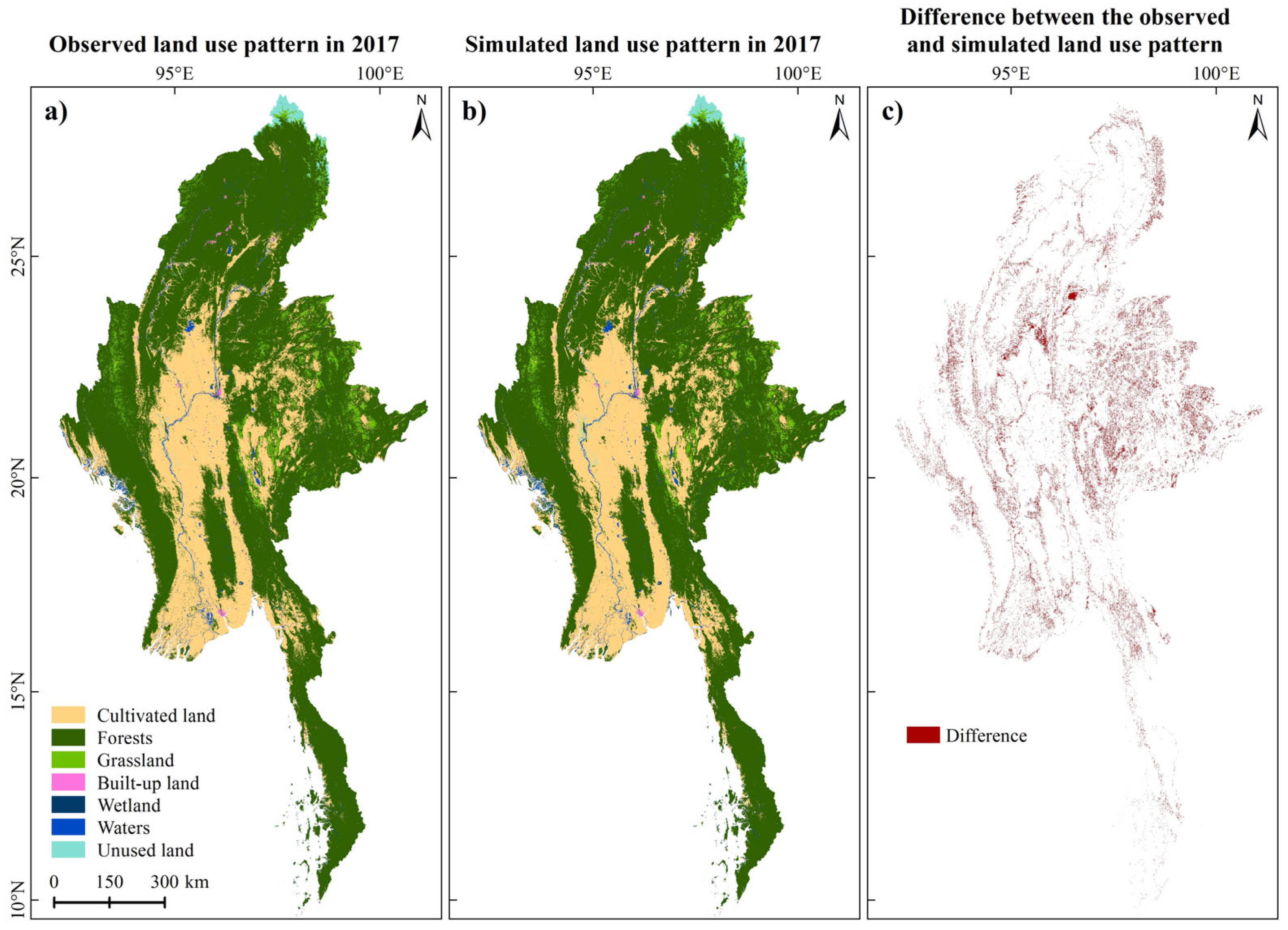
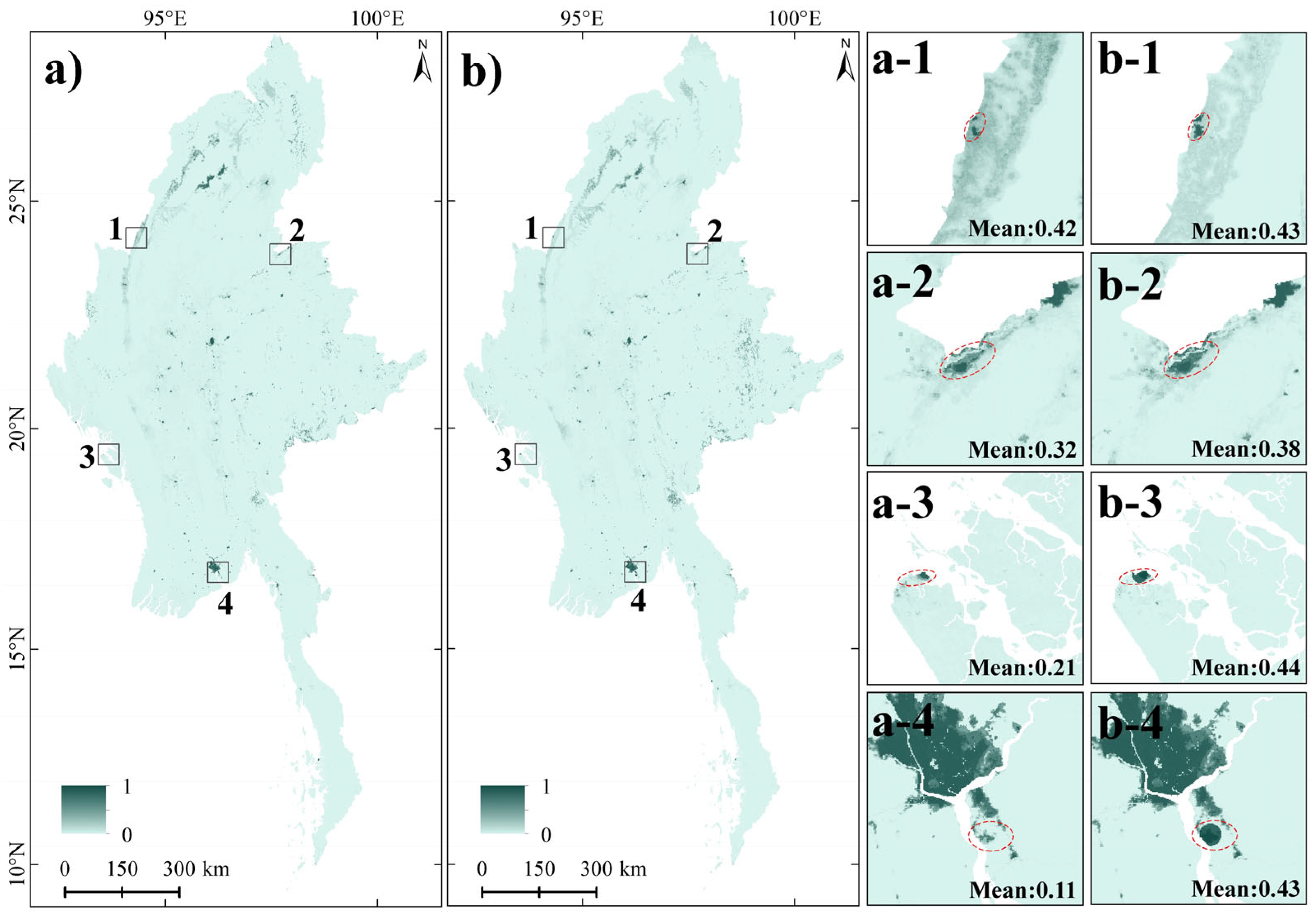

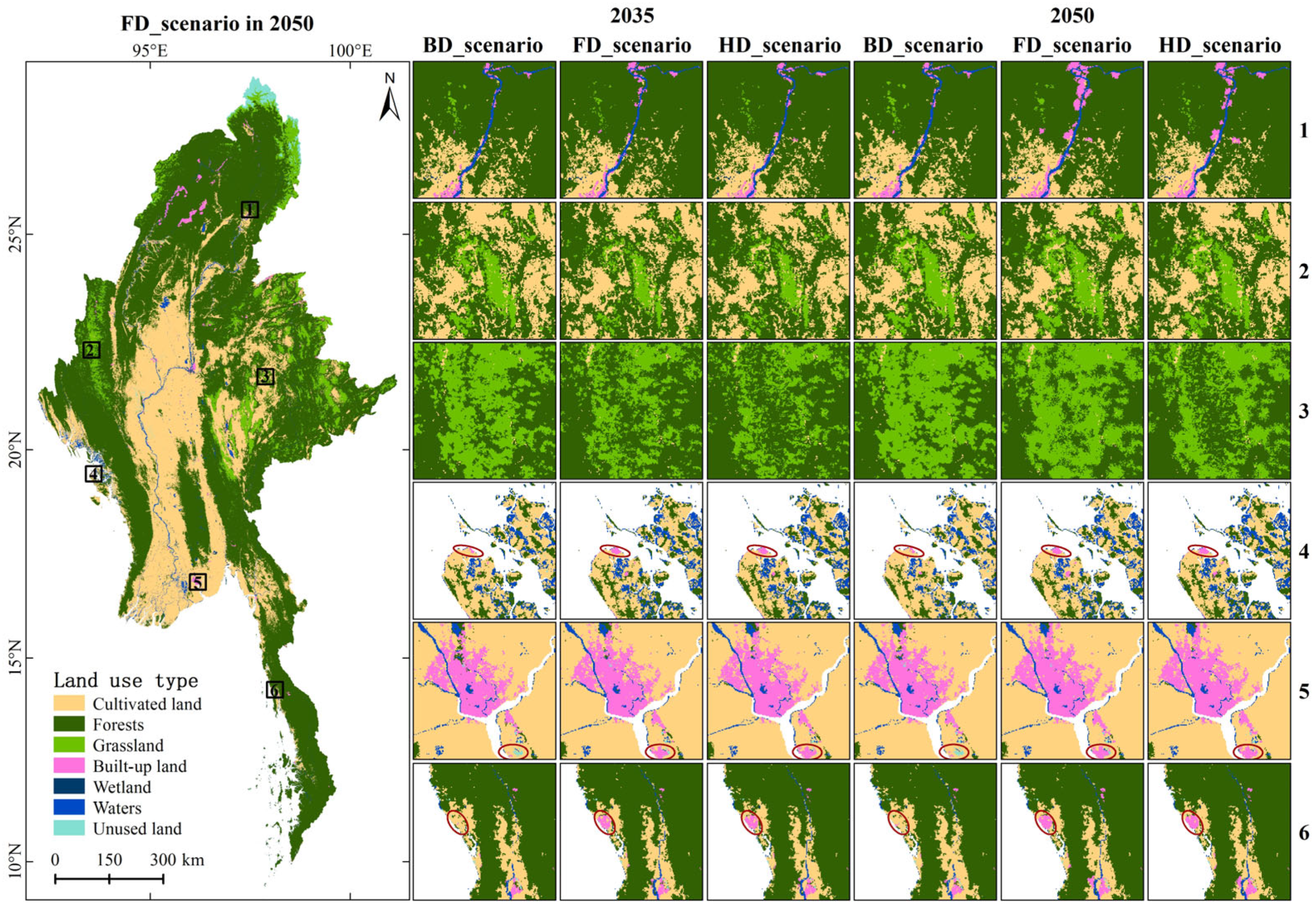
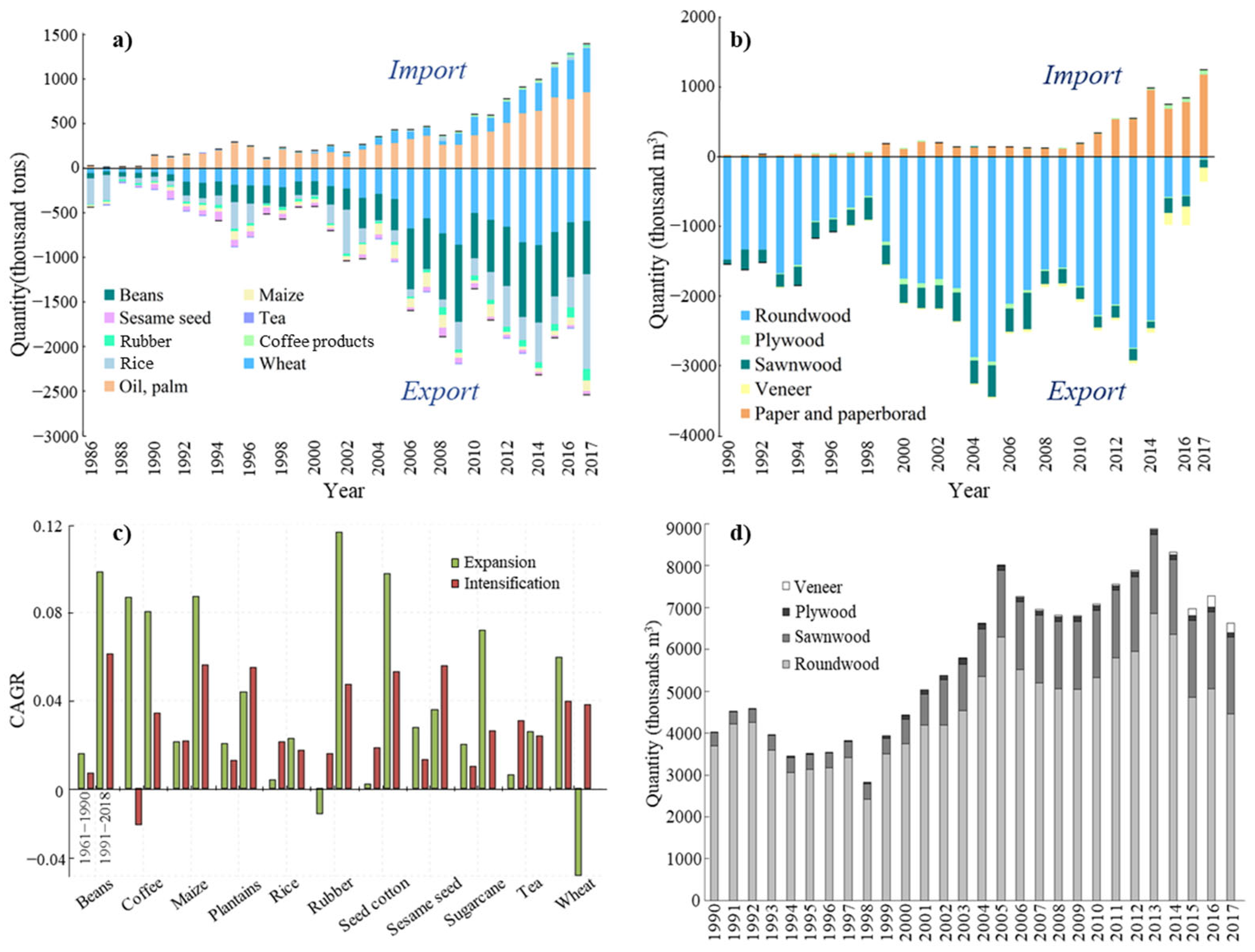
| Category | Data | Driving Factor | Resolution | Year | Reference of the Data Source |
|---|---|---|---|---|---|
| Land use | Land use map | Proximity to disturbed area | 30 m | 2000/2013/2015 /2017/2018 | [43] |
| Socio-economic data | Social Accounting Matrix | _ | _ | 2017 | [44] |
| Population density | Population density | 100 m | 2017 | [45] | |
| Gross Domestic Product (GDP) | GDP | 1 km | 2015 | [46] | |
| Railway stations | Proximity to railway stations | _ | _ | [47] | |
| Road network | Proximity to main roads | _ | _ | [48] | |
| Railway network | Proximity to railways | _ | |||
| Provincial capital sites | Proximity to provincial capitals | _ | |||
| Town sites | Proximity to towns | _ | |||
| Protected area | _ | _ | 2017 | [49] | |
| Natural characteristic data | DEM | DEM | 30 m | _ | [50] |
| Slope | Slope | 30 m | |||
| Soil organic carbon stock | Soil organic carbon stock | 250 m | 2015 | [51] | |
| Soil pH | Soil pH | 250 m | 2015 | [52] | |
| Soil clay content | Soil clay content | 250 m | 2015 | [53] | |
| Annual mean precipitation | Annual mean precipitation | _ | 2008–2017 | [54] | |
| Annual mean temperature | Annual mean temperature | _ | |||
| Future temperature and precipitation | _ | 1 km | 2030/2050 | [42] | |
| Rivers | Proximity to rivers | _ | _ | [48] | |
| Planning data | Planning railway stations | _ | _ | _ | [55] |
| Planning railways | _ | _ | _ | ||
| Economic development zones | _ | _ | _ | [56] |
| Parameter | BD_Scenario | HD_Scenario | FD_Scenario |
|---|---|---|---|
| Investment ratio relative to GDP | 25% | 33% | 40% |
| Growth rate of TFP | 0 | 6% | 6% |
| Growth of population | Low | Medium | High |
| Growth of temperature | 0.04 | 0.065 | 0.085 |
| Growth rate of rainfall | 0.12% | 0.37% | 0.5% |
| Land Use Type | Actual Land Use Quantity (km2) | Projected Land Use Quantity (km2) | Actual Land Use Change Quantity (km2) | Projected Land Use Change Quantity (km2) | Error (%) |
|---|---|---|---|---|---|
| Cultivated land | 208,378.06 | 208,332.81 | 1831.81 | 1786.56 | 2.47 |
| Forests | 515,361.94 | 515,224.5 | −4457.81 | −4595.25 | 3.08 |
| Grassland | 23,938.88 | 24,177.81 | 2102.06 | 2341.0 | 11.37 |
| Built-up land | 2031.69 | 2023.06 | 94.56 | 85.94 | 9.12 |
| Wetland | 1845.69 | 1843.19 | −11.44 | −14.56 | 21.86 |
| Waters | 12,290.06 | 12,250.88 | 418.75 | 379.56 | 9.36 |
| Unused land | 6480.06 | 6474.13 | 22.06 | 16.13 | 26.91 |
| Total | 770,326.38 | 770,326.38 | 8938.5 | 9218.38 | 3.13 |
| Land Use Type | 2013 | 2015 | 2017 | |||
|---|---|---|---|---|---|---|
| Kappa Coefficient | Overall Accuracy (%) | Kappa Coefficient | Overall Accuracy (%) | Kappa Coefficient | Overall Accuracy (%) | |
| Total | 0.84 | 92.30 | 0.83 | 91.99 | 0.84 | 92.29 |
| Cultivated land | 0.87 | 0.87 | 0.87 | |||
| Forests | 0.85 | 0.84 | 0.84 | |||
| Grassland | 0.53 | 0.51 | 0.56 | |||
| Built-up land | 0.74 | 0.74 | 0.75 | |||
| Wetland | 0.62 | 0.61 | 0.63 | |||
| Waters | 0.70 | 0.70 | 0.73 | |||
| Unused land | 0.83 | 0.82 | 0.83 | |||
Disclaimer/Publisher’s Note: The statements, opinions and data contained in all publications are solely those of the individual author(s) and contributor(s) and not of MDPI and/or the editor(s). MDPI and/or the editor(s) disclaim responsibility for any injury to people or property resulting from any ideas, methods, instructions or products referred to in the content. |
© 2023 by the authors. Licensee MDPI, Basel, Switzerland. This article is an open access article distributed under the terms and conditions of the Creative Commons Attribution (CC BY) license (https://creativecommons.org/licenses/by/4.0/).
Share and Cite
Jin, Y.; Li, A.; Bian, J.; Nan, X.; Lei, G. Modeling the Impact of Investment and National Planning Policies on Future Land Use Development: A Case Study for Myanmar. ISPRS Int. J. Geo-Inf. 2023, 12, 22. https://doi.org/10.3390/ijgi12010022
Jin Y, Li A, Bian J, Nan X, Lei G. Modeling the Impact of Investment and National Planning Policies on Future Land Use Development: A Case Study for Myanmar. ISPRS International Journal of Geo-Information. 2023; 12(1):22. https://doi.org/10.3390/ijgi12010022
Chicago/Turabian StyleJin, Yuan, Ainong Li, Jinhu Bian, Xi Nan, and Guangbin Lei. 2023. "Modeling the Impact of Investment and National Planning Policies on Future Land Use Development: A Case Study for Myanmar" ISPRS International Journal of Geo-Information 12, no. 1: 22. https://doi.org/10.3390/ijgi12010022
APA StyleJin, Y., Li, A., Bian, J., Nan, X., & Lei, G. (2023). Modeling the Impact of Investment and National Planning Policies on Future Land Use Development: A Case Study for Myanmar. ISPRS International Journal of Geo-Information, 12(1), 22. https://doi.org/10.3390/ijgi12010022





